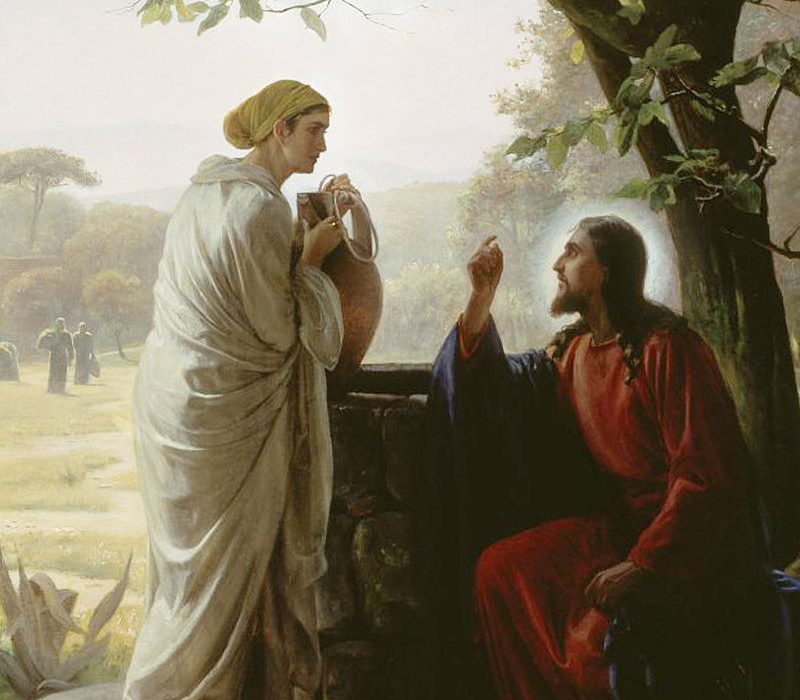March 14, 2017 // Bishop
In Truth and Charity: The woman at the well
This Sunday, the Third Sunday of Lent, we will hear in the Gospel the story of the encounter and conversation of Jesus and the Samaritan woman at the well. I invite you to think about the thirst of Jesus and the thirst of the woman in the Gospel, representing also our thirst, the thirst of our souls.
First, let’s think about Jesus being thirsty. On the surface, Jesus was naturally thirsty. He had been on a long journey on foot and He sat down beside Jacob’s well in the midday heat. Jesus asks the woman for a drink of water. It was quite unusual for a Jewish man to speak to a Samaritan and a woman. But our Lord does so with a deeper motive. He is thirsty for water, yes, but He is also thirsty for the salvation of the Samaritan woman. St. Augustine wrote: Although Jesus asked for a drink, His real thirst was for this woman’s faith.

Carl Heinrich Bloch’s painting, “Woman at the Well,” from the Chapel at Frederiksborg Palace in Copenhagen.
We see this thirst of Jesus again when He is hanging on the cross. Some of His last words at the crucifixion were: I thirst. Yes, Jesus was physically thirsty, but these words have deeper meaning. He is thirsty for our salvation, thirsty for our faith and our love. St. Mother Teresa of Calcutta often meditated on these words of Jesus from the cross. She recognized their deeper meaning. Mother Teresa founded the Missionaries of Charity. In every convent of the sisters throughout the world, the words “I thirst” are displayed beneath an arm of the crucifix.
Mother Teresa wanted the sisters to meditate on these words, to realize that Jesus is thirsting for our love, our affection, our intimate attachment to Him, and our sharing of His passion. God is thirsting for us to come forward to satiate His thirst by giving Him our love and by spreading the love of His heart. God is thirsty for souls. Jesus was thirsty for the soul of the Samaritan woman and brought her to faith. She, in the end, went forth to bring the Good News to her people.
When we look at the crucifix, it is good to remember Jesus’ words: I thirst. God thirsts for us. He thirsts for you and for me. What specifically is Jesus thirsting for in us? He longs for our love, our attention, our devotion, the total entrusting of our lives to Him. Reflecting on Jesus’ words from the cross, Mother Teresa said: “At this most difficult time He proclaimed, ‘I thirst.’ And people thought He was thirsty in an ordinary way and they gave Him vinegar…; but it was not for that thirst; it was for our love, our affection, that intimate attachment to Him, and that sharing of His passion.”
In prayer, I invite you to hear Jesus saying to you: “I thirst.” Imagine Jesus saying those words personally and directly to you. We can then respond to these words by being generous with Jesus with our time, giving Him attention throughout our day, and spending time with Him in prayer. Mother Teresa also taught that we satiate Christ’s thirst by loving Him in our neighbor, those people He places in our lives, especially those in most need of our care and attention. Jesus thirsts for us to surrender our lives to Him, to entrust ourselves to Him.
The other part of today’s Gospel to consider is the thirst of the Samaritan woman. She went every day to the well to draw water. Yes, this was a physical necessity. But again there is something deeper here. The woman had many disappointments in her life. Like all of us, she was thirsty for meaning in her life. She was thirsty for love. Jesus pointed out to her that she had been married five times and now was living with a sixth man. Her life-thirst was not being satisfied. She was unhappy. She wasn’t finding authentic love. She didn’t find anyone or anything to satisfy the deep longing of her heart until she met Jesus.
Our Lord spoke to the Samaritan woman about the living water He would give, the water that would truly quench her thirst and become in her “a spring of water welling up to eternal life.” This is the water we all thirst for, the living water of the Holy Spirit, the water that satisfies our infinite thirst. Pope Francis wrote about this in these words: “Man of every time and place desires a full and beautiful life, just and good, a life that is not threatened by death but that can mature and grow to fullness. Man is like a traveler who, crossing the deserts of life, thirsts for the living water: gushing and fresh, capable of quenching his deep desire for light, love, beauty, and peace. We all feel this desire! And Jesus gives us this living water: He is the Holy Spirit, who proceeds from the Father and whom Jesus pours out into our hearts. “I came that they may have life, and have it abundantly,’ Jesus tells us.”
Lent is a time for us to quench our thirst, to rediscover the meaning of our life in Christ. This is a special time to encounter Jesus like the Samaritan woman at the well, and to be transformed by our encounter with Jesus, like she was. The Lord wants to give us living water. This is why He came to earth, that we might have life and have it abundantly. Sin is an obstacle to that full life in Christ, so we have this time of Lent for our deeper conversion to the Lord.
The Church invites us to drink from the living waters of the Holy Spirit. Then, like the Samaritan woman, we are no longer thirsty. In fact, we are transformed into missionary disciples, who go forth to bring the Good News to others, like the Samaritan woman did and like Mother Teresa did, going forth then to spread the love of Christ and satiate His thirst for the salvation of souls.
The best news. Delivered to your inbox.
Subscribe to our mailing list today.






